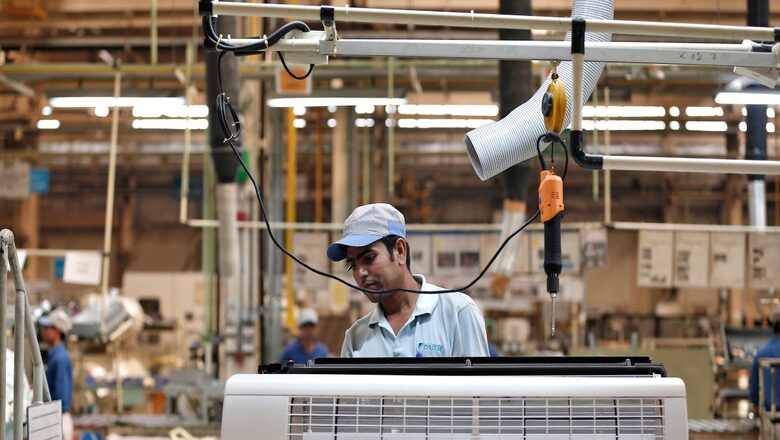
views
Unemployment has become a major concern in recent times, especially with the widening gap between a country’s economic growth and employment generation. The latest Periodic Labour Force Survey (PLFS) for 2022-23 has revealed interesting trends, resulting in a six-year low unemployment rate of 3.2 per cent. However, despite the declining unemployment rate, the general perception is that the employment situation in the country is not positive. As such, there is a need to explore opportunities to deploy the workforce in developed countries, which could be the perfect solution to tackle the unemployment problem.
India has a unique opportunity to export its young workforce and become a significant part of the workforce in developed countries. Developed nations are currently experiencing a shortage of workers, and India can leverage this opportunity by sending its surplus young workforce to these countries. To facilitate this, the Indian government has signed 17 Mobility and Migration Partnership Agreements (MMPA) with countries like Australia, Austria, France, Finland, Germany, Italy, Japan, and the UK. Additionally, agreements are underway with the Netherlands, Greece, Denmark, Switzerland, South Korea, and Taiwan to facilitate the free movement of the workforce.
India’s economy currently ranks 5th in the world and is expected to become the 3rd largest in the future. However, there is a need to improve the relationship between the country’s economic growth and employment generation, as the demographic dividend is not being fully utilised. It is concerning to note that while there are 13 million active job seekers on the Union Ministry of Labour and Employment’s portal, the total number of vacancies in both private and government sectors is only 2.20 lakh.
India is the only country where the supply of young workforce is growing faster than demand. Every year, a massive 12 million young people become employable. This sets India apart from developed countries like the US, Japan, and Germany which have middle-aged or elderly workforce and are facing a severe shortage of young workforce. With a young population (below 35 years) which is set to grow from 62 per cent to 68 per cent by 2030, India has an incredible opportunity to leverage its workforce and meet the demands of developed nations.
Developed countries are facing a serious shortage of workforce, leading to a rise in labour costs and inflation. While they try to keep their manufacturing and service sectors going with new technologies like Artificial Intelligence (AI) and the Internet of Things (IoT), it’s important to note that this approach has its limitations. However, India has a young and abundant workforce that is motivated by a growing working-age population. Therefore, developed nations are considering India’s workforce as they seek to hire skilled workers and keep the costs of their goods and services low.
USA
The latest data unequivocally shows that the US still has three million open jobs, and it’s a fact that there are not enough workers to fill them. The US Chamber of Commerce’s reports paint a clear picture of countless job openings across industries such as transportation, healthcare and social assistance, hospitality and food sectors, manufacturing, wholesale, and retail trade.
According to the survey findings of the US Chamber of Commerce, nearly one in five Americans have altered their livelihood in the last three years. Among them, 17 per cent have retired, 19 per cent have transitioned to become homemakers, and 14 per cent are now working part-time. Additionally, it’s alarming that almost a quarter (24 per cent) of respondents say that government aid packages during the pandemic have disincentivised them from actively seeking work. It’s worth noting that younger respondents, aged 25-34, are prioritising personal growth over job hunting right now. Shockingly, 26 per cent of those surveyed say that they’re more focused on acquiring new skills, education, or training before re-entering the job market.
European Union
The situation is quite alarming in Europe. The current labour shortage is a staggering 14.3 million workers. Shockingly, the European Commission predicts that the EU’s workforce will shrink by 96 million workers by 2030. This potentially catastrophic workforce crunch could lead to a loss of $1.323 trillion in unrealised annual revenue over the next six years.
Despite previous strictness on immigration policies, in the current scenario, the Greek Parliament has now approved an amendment that allows illegal migrants to receive three-year residency and work permits for specific job sectors. As a result, Greece has requested up to 10,000 farm workers from India to address their labour shortage. A significant number of workers from Punjab have already been employed in farming, factory, or construction work there.
Taiwan
India and Taiwan are expected to sign an employment mobility agreement in February 2024. Taiwan plans to recruit up to 100,000 Indian workers for various roles in industries such as factories, farms, and hospitals. This move is due to Taiwan’s ageing population, which is expected to make up over 20 per cent of the population by 2025. To sustain its $790 billion economy, Taiwan is seeking Indian workers and is offering pay parity and insurance benefits to attract them.
Japan
Japan, being the third largest manufacturing nation in the world, is facing an imminent and severe shortage of workforce. This situation is likely to have an enormous impact on Japan’s ability to retain its position as a top manufacturing hub. It’s been predicted that by 2030, Japan may lose out on a staggering $194.61 billion in revenue due to the scarcity of labour.
Germany
Germany is expected to face a significant impact on its manufacturing output due to a labour shortage, following Japan. As a leading manufacturing hub, Germany is currently experiencing a shortage of 2.4 million workers, with the situation expected to worsen. By 2030, it is estimated that Germany’s unrealised revenue will increase to $77.93 billion if the labour shortage reaches 10 million.
The need of the hour
The Ministry of External Affairs’ Overseas Employment Division and Skill India International Centres (SIICs) are expected to take an active role in offering immigration assistance and post-placement support. To equip the workforce with standardisation and certification of skill courses that align with International Occupational Standards, SIICs must work effectively. It is important to utilise the interconnected ecosystem fully to scale up the prospective hires of more workforce and not leave any opportunity unexplored.
The Author is Vice-Chairman of Sonalika Group, Vice-Chairman (Cabinet Minister rank) of the Punjab Economic Policy and Planning Board, Chairman of ASSOCHAM Northern Region Development Council and Chairman of Tractor and Mechanization Association (TMA). Views expressed in the above piece are personal and solely that of the author. They do not necessarily reflect News18’s views.



















Comments
0 comment